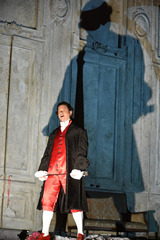| Opera Reviews | 19 April 2024 |
The power structure crumbles in this new Figaroby Steve Cohen |
|
| Mozart: The Marriage of Figaro Opera Philadelphia May 2017 |
|
|
This was the intention of Pierre Beaumarchais when he wrote his play, La Folle Journée, ou Le Mariage de Figaro ("The Mad Day, or The Marriage of Figaro") in 1778, on the eve of the French Revolution, although he clothed his social commentary with the trappings of a domestic comedy. And it’s what Lorenzo da Ponte and Wolfgang Amadeus Mozart designed when they fashioned their opera in 1786. They highlighted mistaken identities and misunderstandings, setting a standard that’s been copied but never surpassed in movies and sitcoms, while adding profound human fears, sadness and anger. Stephen Lawless has directing experience with the Royal Opera House, Covent Garden; the Vienna State Opera; and the Metropolitan Opera. In this new production, he tries something new. With sets and costumes by Leslie Travers, he presents an extravagantly ornate palace, staffed by servants in crimson livery and powdered wigs. This emphasizes the wealth and power of Count Almaviva more than any other production. The sets prominently reveal corridors where servants skulk, and multiple doors where they peek in at the activities of their rulers. The doors provide many comic opportunities; they also remind me of Stephen Sondheim’s “Opening Doors” which hint at future opportunities. This is a co-production of Opera Philadelphia, Lyric Opera of Kansas City, San Diego Opera and Palm Beach Opera, although each company is choosing its own conductor and cast. Count Almaviva (John Chest) has a lovely wife (Layla Claire) but carries on sexually with several of his servants and with the teenage daughter of his gardener. The count’s manservant Figaro (Brandon Cedel) is about to marry the countess’s maid Susanna (Ying Fang) and Almaviva sets them up in a bedroom adjoining his own. Susanna is savvy enough to see that the count wants to have quick access to her for sex when Figaro is away from the room. It’s clear that the women are more aware than the men of what’s going on, as Figaro originally seems clueless about Almaviva’s plan. This production clearly shows the women as the instigators and leaders of a scheme to embarrass Almaviva. That’s an unusual revelation of feminism by da Ponte and Mozart! Lawless’s direction includes many sexual references without resorting to crudeness. The countess reveals, through glances and hesitations, that she’s attracted to the teenaged boy Cherubino (Cecelia Hall), while Cherubino lusts after every female he meets. The countess is aware of her husband’s infidelities. She pours out her soul in Porgi, amor, qualche ristoro – "Grant, love, some comfort" in act II and Dove sono i bei momenti – "Where are the beautiful moments" in act III. At the end of the garden scene, Almaviva has a rare moment of remorse and sings Contessa, perdona – “Please forgive me.” Rovaris had the orchestra take a delicious moment of silence here, before the countess responded that she, as a woman, can be more understanding than any man, and she pardons him. But he better be on guard in the future; his days of autocratic entitlement are numbered. Music director Corrado Rovaris presented this The Marriage of Figaro as an intimate human story, having the orchestra pit raised so he was visible as he sat at a harpsichord with his head at the same level as audience members. This maintained a close relationship with the singer-actors in front of him. My only quibble concerns the fact that the antagonists Figaro and Count Almaviva are each sung by a baritone. The drama works best when the count has a darker baritone voice, such as George London or Kim Borg in the past, thus providing a noticeable contrast between the two and making the Figaro seem like the brighter personality while Almaviva is more evil. I admit that an opposite approach has some merit, and if Figaro has the darker voice it could indicate that he’s a grounded person, while a slightly-lighter Almaviva would hint at his insecurities. Here the two men had similar vocal color. Almost to the end, Almaviva remains as an entitled ruler who wails about how unfair it is for him to experience troubles while his servants are happy. Meanwhile, his wife (although sympathetic most of the time) retains the arrogance of power as she says “It infuriates me to have to seek help from my servants.” In the final scene, this production shows a crumbling facade of Almaviva’s mansion, and some of his furniture is askew. The Revolution is just around the corner.
|
|
| Text ©
Steve Cohen Photo © Kelly & Massa Photography |

 This production of The Marriage of Figaro (Le nozze di Figaro) portrays the crumbling of a way of life. The top One Per Cent are being challenged by their underlings. The common people are asserting the rights of workers and of women, and the aristocrats are in danger of losing their privileged position.
This production of The Marriage of Figaro (Le nozze di Figaro) portrays the crumbling of a way of life. The top One Per Cent are being challenged by their underlings. The common people are asserting the rights of workers and of women, and the aristocrats are in danger of losing their privileged position.





